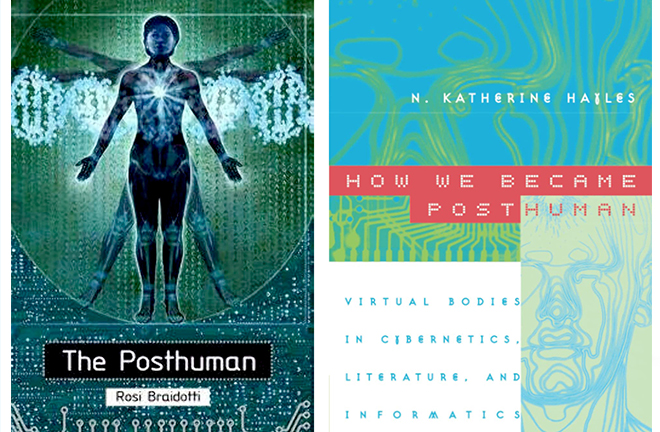Posthuman landscape in science fiction

FILE PHOTO: How We Became Posthuman: Virtual Bodies in Cybernetics, Literature, and Informatics by N. Katherine Hayles and The Posthuman by Rosi Braidotti
In recent years, groundbreaking advancements in artificial intelligence (AI) have sparked heated debate on whether AI will develop consciousness, whether it might possess human-like self-awareness, and what kind of future AI technology could shape for humanity. This has intensified interest in the concept of posthumanism that emerged in the late 20th century. As a genre of literature and art that envisions and constructs the future, science fiction explores the prospects of technological and social development, potential dilemmas, and possible solutions. The posthuman landscape in science fiction represents not only an anticipation of the future but also a critical reflection on the present, urging humanity to engage with the “technological society” more rationally.
New life forms
The ongoing development and convergence of bioscience, neuroscience, and information sciences are helping unlock the secrets of human life, while also inspiring science fiction in its imaginative portrayal of the future. From enhanced human capabilities to artificial and extraterrestrial life, these imaginative scenarios speculate on humanity’s evolution and potential challenges ahead.
The transhumanist future: The human body is not only enhanced by external prosthetics but also undergoes genetic modification to surpass the limitations of physical existence, realizing the transhumanist dream of becoming evolution’s ultimate apex predator. Science fiction portrays many transhuman figures who may either be heroes, saving ordinary humans, or villains, inflicting harm on humanity.
The future of artificial life: Large numbers of artificial life forms, such as robots, androids, and clones, are created to serve humanity. Similarly, this leads to either a bright future or some apocalyptic end. Artificial life forms, if relegated to the lowest tier of labor in society, may eventually come into extreme opposition with humans, sparking human-machine wars.
The future of non-human life: Interstellar space travel becomes a reality, and alien civilizations will visit Earth. Humans are displaced by extraterrestrials or otherwise undermined by the evolution and proliferation of other organisms, including microorganisms. As humanity loses control over its destiny, anthropocentrism completely dissolves.
Through these three scenarios, science fiction conveys humanity’s longing, vigilance, and fear regarding the evolution of the human body, while also prompting readers to reflect on the relationship between humans and other life forms.
New social relations
In science fiction, the anthropocentric dualistic worldview is revisited, and the constructed nature-culture dichotomy transitions to nature-culture integration. This transition produces two new forms of social relations.
Weak dualism and revising anthropocentrism: By fostering a recognition of heterogeneity in human interactions with non-human life, this relationship allows humanity to reexamine both Earth and the universe, as well as understand and embrace non-human life, thereby developing a symbiotic human-Other relationship.
Holistic (Monistic) relations and reconstructing worldviews: This requires reconsidering the categories themselves, reimagining all species and beings relevant to humanity, and constructing new forms of existence and interrelation. On this basis, humanity will fundamentally acknowledge artificial life and coexist with it. The hybridization of humans, animals, machines, and technology will give rise to new variations and life systems.
Symbiotic cyborg landscape
Science fiction has produced many riveting stories of humans interacting with artificial and non-human life, presenting unprecedented social relationships. The author refers to this as the “cyborg landscape.” Here, the term “cyborg” signifies not only human-machine integration on a physical level but also a social structure in which humans coexist with various non-human life forms.
According to N. Katherine Hayles, “in the posthuman, there are no essential differences or absolute demarcations between bodily existence and computer simulation, cybernetic mechanism and biological organism, robot teleology and human goals.” Rosi Braidotti argues that posthumanism can serve as a frame of reference for considering what constitutes the basic unit of reference for the human identity, and what fundamental principles should govern human interactions with non-human life. Together, their perspectives indicate the dissolution of dualistic, human-constructed epistemology, as humanity embraces new life forms, adjusts the social trajectory, and cultivates a symbiotic relationship with all beings.
Therefore, some scholars argue that posthumanism serves as an “affirmative ethics” grounded in a reverence for relational networks, rather than a reimagination of modernity based on the ethics of commercial exchange. Confronted with such a future, we may find meaning in life by harnessing reason constructed through cultural memes, integrating the unity of nature and culture, and thus transcending the limitations of the physical body to attain freedom.
Jiang Yuqin is a professor from the School of Literature at Shenzhen University.
Edited by WANG YOURAN

 PRINT
PRINT CLOSE
CLOSE